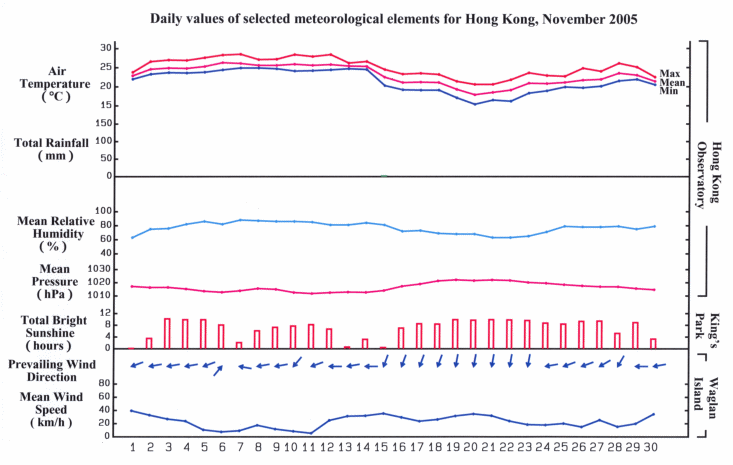The Weather of November 2005
|
November 2005 was much warmer than normal. The mean minimum temperature of 21.4 degrees equals the record high for November set in 1998. The monthly mean temperature of 23.0 degrees was also the fourth highest for November. The total rainfall in the month was only 1.6 millimetres, 33.5 millimetres below the normal figure. The accumulated rainfall since 1 January was 3205.0 millimetres, 47 % above the normal figure of 2187.0 millimetres for the same period. It was mainly cloudy on the first two days of the month. Clouds dispersed on 3 November and the weather became generally fine and warm for the next nine days under the influence of a ridge of high pressure. On 10 November, the visibility in the harbour dropped below 2000 metres in mist patches in the morning. The weather turned cloudy on 13 and 14 November as winds freshened from the east. In the absence of any significant surge of the northeast monsoon, the first two weeks of the month was unseasonably warm in Hong Kong. The mean minimum temperature at the Hong Kong Observatory during the period was 24.1 degrees, the highest for the same period in November. A cold front moved across the south China coast on the early morning of 15 November and brought some rain to the territory. The weather became cooler that night. The dry continental airstream behind the cold front cleared the sky on 16 November. With the northeast monsoon prevailing over southern China, the weather in Hong Kong was fine, dry and cool in the following six days. The temperature at the Hong Kong Observatory dropped to a minimum of 15.4 degrees on 20 November, the lowest in the month. The weather became hazy on 23 November and remained so until the end of the month. Three tropical cyclones occurred in the western North Pacific and South China Sea in the month. |
|
Details of issuance and cancellation of various warnings/signals in the month are summarized in Table 1. Monthly meteorological figures and departures from normal for November are tabulated in Table 2. |
Warnings and Signals issued in November 2005
| Colour | Beginning Time | Ending Time | ||
|---|---|---|---|---|
| Day/Month | HKT | Day/Month | HKT | |
| Yellow | 6 / 11 | 0615 | 6 / 11 | 1800 |
| Yellow | 13 / 11 | 0845 | 13 / 11 | 1800 |
| Yellow | 19 / 11 | 0000 | 20 / 11 | 2315 |
| Yellow | 27 / 11 | 0600 | 27 / 11 | 1830 |
| Meteorological Element | Figure of the Month | Departure from Normal* |
|---|---|---|
| Mean Daily Maximum Air Temperature | 25.0 degrees C | 0.8 degree above normal |
| Mean Air Temperature | 23.0 degrees C | 1.6 degrees above normal |
| Mean Daily Minimum Air Temperature | 21.4 degrees C | 2.2 degrees above normal |
| Mean Dew Point Temperature | 18.6 degrees C | 3.4 degrees above normal |
| Mean Relative Humidity | 77 % | 8 % above normal |
| Mean Cloud Amount | 55 % | 2 % above normal |
| Total Rainfall | 1.6 mm | 33.5 mm below normal |
| Number of hours of Reduced VisibilityΔ | 219 hours | 90.9 hours above normal§ |
| Total Bright Sunshine Duration | 210.0 hours | 28.5 hours above normal |
| Mean Daily Global Solar Radiation | 12.53 Megajoule / square metre | 0.86 Megajoule below normal |
| Total Evaporation | 93.1 mm | 36.0 mm below normal |
| Remarks : | All measurements were made at the Hong Kong Observatory except sunshine, solar radiation and evaporation which were recorded at King's Park Meteorological Station and visibility which was observed at the Hong Kong International Airport. |
| Δ |
The visibility readings at the Hong Kong International Airport are based on hourly observations by professional meteorological observers in 2004 and before, and average readings over the 10-minute period before the clock hour of the visibility meter near the middle of the south runway from 2005 onwards. The change of the data source in 2005 is an improvement of the visibility assessment using instrumented observations following the international trend. |
* Departure from 1961-1990 climatological normal, except for number of hours of reduced visibility. |
|
| § Departure from mean value between 1997 and 2004. | |
